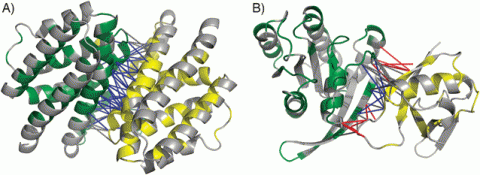Predicting protein-protein interaction specificity through the integration of three-dimensional structural information and the evolutionary record of protein domains

Panjkovich A, Aloy P, Protein-protein interactions are central to most biological processes. Although much recent effort has been put into experimental and computational methods to identify and model interacting partners, there has been a limited focus on how these interactions achieve the high degree of specificity observed. Accordingly, we describe a computational strategy that scores protein-protein interactions by means of a statistical potential combined with homology modelling of the putative complexes. The novelty of the method lies in the fact that it considers the evolutionary conservation of the residue contacts participating in the binding interfaces, following the hypothesis that those contacts that are conserved across a large fraction of interologues (i.e. homologous interacting protein pairs) might be responsible for the binding, while those that are specific for each interaction pair would determine the specificity. We evaluate the method on a non-redundant set of all interacting protein families of known three-dimensional structure and on specific cases where interaction specificities have been experimentally characterised, such as the Skp1, Ras and fibroblast growth factor families. Our results show that it is indeed possible to increase the accuracy of in silico prediction of protein-protein interactions by considering the relationship between interaction specificity and the degree of contact conservation in the binding interfaces.
Mol Biosyst,
2010, 6(4), 741-9
Pubmed: 20237652
Direct link: 10.1039/B918395G
